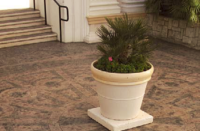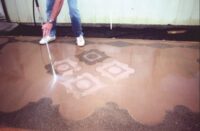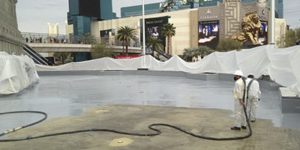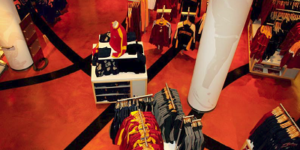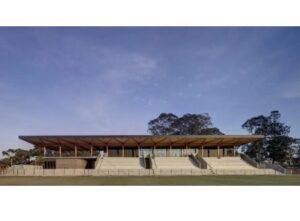Texas Christian University’s football program has emerged as a national power over the past few years, and for a smallish university (enrollment under 10,000) that’s quite an accomplishment. It stands to reason that a big-time football program would want to play in a big-time stadium.
When the University embarked on a two-year renovation of venerable Amon G. Carter Stadium immediately following the 2010 football season, the stated goal was to enhance the game-day experience for every fan.
That enhanced experience begins as fans work their way from the parking lot to the renovated stadium. Many of them cross the new Founders’ Plaza, which feature bronze plaques honoring key donors, tributes to university pioneers, and a huge decorative concrete depiction of the environs of Fort Worth, Texas, the town in which the University is located.
How does one depict the look and feel of a town in concrete, you ask? Bring in Texas Bomanite.
Scott Balch, president of Texas Bomanite, based in Dallas, describes the TCU job as “a very large project.” Chandler Balch, senior estimator for the company, calls it “complex.” Large and complex is a fair description of what Texas Bomanite specializes in. The company’s resume includes work on the Dallas Cowboys stadium, the Texas Rangers stadium and the largest mall in the Dallas area.
“We were involved with the Founders’ Plaza part of the job from the design side of things pretty much from the beginning,” says Chandler Balch.
Newman, Jackson, Bieberstein Inc., (NJB) the landscape architecture firm tasked with designing the plaza, consulted with Texas Bomanite about different finishes. That led to meetings with the university and Austin Commercial LP, the general contractor on the project, Balch says. “Initial meetings focused on how to accomplish the look they wanted with pavers … and then gray concrete and topical stains.”
 The architectural team, consisting of NJB and the stadium redevelopment’s lead architectural firm, HKS, wanted to depict an accurate representation of downtown Fort Worth in 1930, when the original Amon G. Carter stadium was finished, says NJB associate Megan Abernathy. “We had a 1930s map that included streets, the Trinity River and railroad tracks, all the intricate details we needed. Initially we were thinking about using pavers because we could get the colors we wanted that way. When we decided that the pavers might not quite get us there, we contacted Texas Bomanite. We met with Chandler Balch and that’s when the brainstorming began.”
The architectural team, consisting of NJB and the stadium redevelopment’s lead architectural firm, HKS, wanted to depict an accurate representation of downtown Fort Worth in 1930, when the original Amon G. Carter stadium was finished, says NJB associate Megan Abernathy. “We had a 1930s map that included streets, the Trinity River and railroad tracks, all the intricate details we needed. Initially we were thinking about using pavers because we could get the colors we wanted that way. When we decided that the pavers might not quite get us there, we contacted Texas Bomanite. We met with Chandler Balch and that’s when the brainstorming began.”
The initial collaborative efforts led to a noncompetitive bid, and Texas Bomanite began working on the details of how to accomplish the work by the deadline — the first football game of the 2012 season.
Inlays in the heat
One of the problems coming out of the gate was that the plaza area was the main route for contractors working on other parts of the stadium. “We were significantly delayed by almost two months, because we had to wait until starting our job wouldn’t slow down other aspects of the renovation,” says Balch.
Once they began, Texas Bomanite worked with single-minded purpose. That’s not to say there weren’t other obstacles to work around in the Texas heat. “The weather made things more difficult,” says Balch. “In the summertime, Fort Worth gets pretty hot by nine in the morning and blazing hot by noon. Normally, we would have moved our daily start time to very early in the morning, but because there was a neighborhood nearby, we couldn’t start working until six in the morning. We spent mornings pouring concrete and afternoons stripping forms, building forms for upcoming pours, and tying rebar.”
Other issues had to do with the scope and complexity of the job. The crews started by pouring 1-foot-wide bands depicting the grid of Fort Worth’s 1930 streets. The resulting grid served as the baseline from which all the other concrete pours would be placed. “The bands had to be dead-on straight with lots of expansion joints,” says Balch. “We knew if we got those right, we’d be okay on everything else. Another band of concrete, representing railroad tracks, curves through the grid of streets, and that had to be perfect too.”
Each “street” included stainless steel letters inlaid to identify the street names. The inlays were placed in a mud bed and integrally colored concrete was poured around them. Solar lights ($400 apiece) were inlaid at each intersection — more than 90 of them in all. “The most important thing was making sure that they would be perfectly even with the concrete so there wouldn’t be a tripping hazard,” says Balch.
The design called for the concrete on the plaza to be 7 inches thick rather than the more traditional 4 inches. Balch says the reason for the added thickness is that vehicles will sometimes be driving on the surface.
Because there were so many inlays, nearly all the concrete (650 cubic yards) was placed using wheelbarrows rather than a pump. “We did a lot of 3- to 5-yard pours,” says Balch.
Installing the river
The Trinity River skirts downtown Fort Worth, so an accurate portrayal of the city had to include a river. “One of the reasons we wanted Texas Bomanite to do the job was that we saw pictures of how they’re able to mimic a river and riverbank,” says Abernathy. “The way they had done it before was with hand-troweling, but that method is labor-intensive and expensive. Texas Bomanite designed a special set of stamps to create the texture and look that we wanted. It came out perfectly, and just as importantly, it fit into the budget.”
“They aren’t your typical stamps,” explains Balch. “Essentially they represent the ripples and lines you might see in running water, as well as the water- and wind-swept sandy bank of a river. They aren’t designed to line up with each other like typical stamps, so there is still a lot of craftsmanship involved on the part of the person doing the stamping — they have to be lined up by eye. When it is done right, there is a natural-looking flow to the texture. We’ve added these stamps to our inventory and I’m certain we’ll use them again.
“A nice touch to the river is that we embedded rope lights through it,” he adds. “It looks great at night.”
All kinds of finishes
Texas Bomanite used a variety of finishes, stains and decorative saw cuts to highlight the work. The river itself consists of a band of seeded aggregate down the middle, flanked by stamped banks.
A fire lane required by city code threatened to not blend in with the other work. Ultimately the city agreed to allow the team to dress things up with Bomanite Con-Color stain, decorative saw cuts and sandblasting.
In most of the areas between the grids of the streets, workers used heavy-seeded exposed aggregate and integral colors. The circle in the area with the monuments in honor of the founders, plus another circle at the beginning of the river, were finished with Sandscape Texture, a proprietary Bomanite finish. Topical stains were used as accents to pop colors.
Patrick Mucker, project manager, TCU physical plant, says using integral color for the bulk of the concrete provided a better appearance than staining would have. “Integral color was the best way to bring attention to the Founders’ Plaza while providing an elegant look to honor our donors,” he says.
 A satisfying result
A satisfying result
The team effort seems to have paid off, producing a beautiful concrete spread as well as some lasting professional bonds.
Ben Austin, project manager for Austin Commercial, says he looks forward to working with Texas Bomanite again. “Once we knew we wanted Bomanite finishes on the Plaza, the choice to hire Texas Bomanite was easy. Those guys were on top of the job from the start. And most importantly, TCU was happy with the end result.”
Mucker of TCU is impressed as well. “We had a very large plaza area and a tight schedule to complete the work before our first game — our schedule was the biggest challenge,” he says. “I didn’t realize the complexities of the work until it was complete. People expect a typical concrete plaza to go in quick, but this is not a typical plaza and to get it done the right way took some time. Austin and Bomanite did a great job managing the work with major construction activities finishing in adjacent areas.”
“Had we not been able to connect with Texas Bomanite, I don’t think we would have ended up with the great result they were able to achieve,” says Abernathy of NJB. “They took our design team’s idea of what we wanted the Founders’ Plaza to look like and they made it happen.
Project at a Glance
Client: Texas Christian University, Fort Worth, Texas
Decorative Concrete Contractor: Texas Bomanite, Dallas | www.texasbomanite.com
Founders’ Plaza Architect: Newman, Jackson, Bieberstein Inc., Dallas, Texas
Lead Architect: HKS Inc., Dallas, Texas | www.hksinc.com
General Contractor: Austin Commercial LP, Austin, Texas | www.austin-ind.com
Scope of project: Hardscapes at Amon G. Carter Stadium redevelopment project
Most challenging aspects: A complex design due to the layout and the number of finishes, scheduling
Products Used: Bomanite Sandscape Texture; Bomanite Imprint System; Bomanite Con-Color penetrating stain in Shale Gray, Brick Red, Sonora Tan, Brownstone and Café Au Lait; Bomanite integral color in Gobi Desert, Coal Gray and Seal Gray

